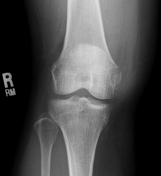Items tagged “ligament”
44 results found
Article
Acetabular labrum
Acetabular labrum acts to deepen the acetabulum and increase contact between the pelvis and the femoral head. Its exact biomechanical role remains to be fully elucidated.
Gross anatomy
The acetabular labrum is a C-shaped fibrocartilaginous structure with an opening anteroinferiorly at the site...
Article
Posterolateral ligamentous complex
The posterolateral ligamentous complex (also known as the arcuate ligamentous complex) of the knee is an important stabilizer and consists of a number of structures. Depending on the publication/definition more or less of the following structures are included 1-4:
lateral (fibular) collateral l...
Article
Arcuate ligament
The arcuate ligament is part of the posterolateral ligamentous complex of the knee that is variably present, being found in ~65% (range 47.9-71%) of knees. It is a Y-shaped thickening of the posterolateral capsule, which arises from the fibular styloid and divides into two limbs:
medial limb: c...
Case
Hill-Sachs lesion

Published
08 Oct 2010
80% complete
MRI
Article
Iliolumbar ligament
The iliolumbar ligament is a strong band of connective tissue which courses from the transverse process of L5 (in over 96% of cases) to the posterior iliac wing and crest of the ilium. It functions to maintain the alignment of L5 on the sacrum during various movements 1,2.
It is an important la...
Article
Anterior cruciate ligament
The anterior cruciate ligament (ACL) is one of the two cruciate ligaments that stabilize the knee joint.
Gross anatomy
The ACL arises from the anteromedial aspect of the intercondylar area on the tibial plateau and passes upwards and backwards to attach to the posteromedial aspect of the late...
Article
Triangular space of cruciate ligaments
Triangular space of cruciate ligaments (TSC) is defined as the potential extrasynovial space between anterior and posterior cruciate ligaments of the knee joint.
Gross anatomy
Boundaries
anteriorly: anterior cruciate ligament
posteriorly: posterior cruciate ligament
inferiorly: tibial plate...
Article
Lateral collateral ligament of the ankle
The lateral collateral ligament (complex) of the ankle is a set of three ligaments that resist inversion of the ankle joint. They are more commonly injured than the medial collateral (deltoid) ligament of the ankle. They run from the lateral malleolus of the fibula to the talus and calcaneus.
...
Article
Calcaneofibular ligament
The calcaneofibular ligament (CFL) is the middle ligament of the lateral collateral ligament complex of the ankle and stabilizes both the ankle and subtalar joints.
Gross anatomy
The CFL is an extracapsular round cord measuring 20-25 mm long x 6-8 mm width. Its origin is distal to the anterior...
Case
Proximal MCL osseous avulsion

Published
20 Nov 2014
91% complete
X-ray
Article
Anterior longitudinal ligament
The anterior longitudinal ligament (ALL) runs along the anterior surface of the vertebral bodies (firmly united to the periosteum) and intervertebral discs (attaching to the anterior annulus). It ascends from the anterosuperior portion of the sacrum superiorly to become the anterior atlantooccip...
Article
Anterior atlanto-occipital membrane
The anterior atlanto-occipital membrane is a thin membrane that joins the upper border of the anterior arch of the atlas (C1) to the anterior inferior surface of the foramen magnum. It is a continuation of the anterior longitudinal ligament above the C1 level. It is immediately posterior to the ...
Article
Apical ligament
The apical ligament is a small ligament that joins the apex (tip) of the dens of C2 to the anterior margin (basion) of the foramen magnum. It is the weak, fibrous remnant of the notochord and does not contribute significantly to stability.
The more posterior alar and cruciate ligaments are stro...
Article
Alar ligament
The alar ligaments join the lateral margins of the sloping upper posterior margin of the dens of C2 to the lateral margins of the foramen magnum (adjacent to the occipital condyles) and lie on either side of the apical ligament. They may be oblique or vertical and are thickest at the occipital a...
Article
Cruciate ligament of the atlas
The cruciate ligament of the atlas (also known as the cruciform ligament) is an important ligamentous complex that holds the posterior dens of C2 in articulation at the median atlantoaxial joint. It lies behind a large synovial bursa (surrounded by loose fibrous capsule) and consists of two band...
Article
Posterior longitudinal ligament
The posterior longitudinal ligament (PLL) is a long and important ligament located immediately posterior to the vertebral bodies (to which it attaches loosely) and intervertebral discs (to which it is firmly attached).
It extends from the back of the sacrum inferiorly and gradually broadens as ...
Article
Tectorial membrane of the spine
The tectorial membrane is the thin superior continuation of the posterior longitudinal ligament from the body of the axis. It joins the axis body to the clivus on the anterior half of the foramen magnum, and ascends as high as the spheno-occipital synchondrosis and laterally extends to the hypog...
Article
Ligamentum flavum
The ligamenta flava (singular: ligamentum flavum) are paired ligaments which run between adjacent laminae of the vertebral bodies and are present from C2/3 to the sacrum. Above the C2/3 level, the equivalent structures are known as the posterior atlanto-occipital membrane between the skull base ...
Article
Posterior atlanto-occipital membrane
The posterior atlanto-occipital membrane attaches the anterosuperior border of the posterior arch of the atlas (C1) to the posterior margin of the foramen magnum. It lies immediately posterior to the spinal theca and is continuous inferiorly with the ligamentum flavum (sometimes referred to at C...
Article
Interspinous ligament
The interspinous ligaments join the spinous processes along their adjacent borders. They are composed of relatively weak fibrous tissue that fuses with the stronger, supraspinous ligaments.







 Unable to process the form. Check for errors and try again.
Unable to process the form. Check for errors and try again.